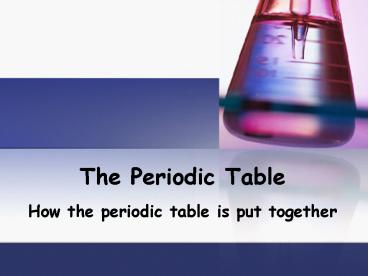The Periodic Table - PowerPoint PPT Presentation
1 / 24
Title:
The Periodic Table
Description:
The Periodic Table How the periodic table is put together – PowerPoint PPT presentation
Number of Views:226
Avg rating:3.0/5.0
Title: The Periodic Table
1
The Periodic Table
- How the periodic table is put together
2
(No Transcript)
3
What is the Periodic Table?
- It is an organizational system for elements.
Picture from www.chem4kids.com
4
Who created it?
- The quest for a systematic arrangement of the
elements started with the discovery of individual
elements. - By 1860 about 60 elements were known and a
method was needed for organization. - In 1869, Russian chemist Dimitri Mendeleev
proposed arranging elements by atomic weights and
properties. - The table contained gaps but Mendeleev predicted
the discovery of new elements.
5
What do all the numbers mean ?
From www.science-class.net
6
What do the symbols and numbers mean?
- Symbol- one or two letter abbreviation which
comes from the elements English or Latin name - Name- Elements common name
- Atomic Number- Equal to the number of protons ()
or the number of electrons (-) in the electron
cloud. - Atomic Mass- the mass of the atom or element.
- (end)
7
So how is it arranged?
- The genius of the periodic table is that it is
organized like a big grid. The elements are
placed in specific places because of the way they
look and act. If you have ever looked at a grid,
you know that there are rows (left to right) and
columns (up and down). The periodic table has
rows and columns, too, and they each mean
something different. - quoted from http//www.chem4kids.com/files/elem_pe
rtable.html
8
You've got Your Periods...
- Even though they skip some squares in between,
all of the rows go left to right. When you look
at a periodic table, each of the rows is
considered to be a different period (Get it? Like
PERIODic table.) - quoted from http//www.chem4kids.com/files/elem_pe
rtable.html
9
Periods Rows
- In the periodic table, elements have something in
common if they are in the same row. - All of the elements in a period have the same
number of atomic orbitals. - Every element in the top row (the first period)
has one orbital for its electrons. All of the
elements in the second row (the second period)
have two orbitals for their electrons. It goes
down the periodic table like that. - quoted from http//www.chem4kids.com/files/elem_pe
rtable.html
10
And you got your groups
- The periodic table has a special name for its
columns, too. When a column goes from top to
bottom, it's called a group. - quoted from http//www.chem4kids.com/files/elem_pe
rtable.html
11
Groups Columns
- The elements in a group have the same number of
electrons in their outer orbital. - Every element in the first column (group one) has
one electron in its outer shell. Every element on
the second column (group two) has two electrons
in the outer shell. As you keep counting the
columns, you'll know how many electrons are in
the outer shell. - There are some exceptions to the order when you
look at the transition elements, but you get the
general idea.
12
Outer Shell
- The electrons in the outer shell (or outer
orbital) are called Valence Electrons
13
How do we figure out the Valance Electrons?
- The closest shell to the nucleus is called the "1
shell" (also called "K shell") - Followed by the "2 shell" (or "L shell")
- Then the "3 shell" (or "M shell")
- The shells correspond with the principal quantum
numbers (n 1, 2, 3, 4 ...) or are labeled
alphabetically with letters used in the X-ray
notation (K, L, M, ).
Dont need to know for quiz
14
Valance Electrons
- Each shell can contain only a fixed number of
electrons - The 1st shell can hold up to two electrons
- The 2nd shell can hold up to eight (2 6)
electrons - The 3rd shell can hold up to 18 (2 6 10) and
so on.
Do not need to know for quiz
15
Other than periods and groups, the table is
divided into families.
From www.science-class.net
16
ALKALI METALS
- very reactive metals that do not occur freely in
nature - malleable, ductile, good conductors of heat and
electricity. - can explode if they are exposed to water
From www.science-class.net
17
ALKALINE EARTH METALS
- metals
- very reactive
- not found free in nature
- Low Density
- High Boiling Point
- Found in compounds
From www.science-class.net
18
TRANSITION METALS
- ductile and malleable, and conduct electricity
and heat - iron, cobalt, and nickel, are the only elements
known to produce a magnetic field (paramagnetic). - Form compounds
From www.science-class.net
19
RARE EARTH ELEMENTS
- many are man-made
- Not very rare, abundant
- Green Element
- Hard to isolate
- Reactive, compounds and minerals
From www.science-class.net
20
OTHER METALS
- are ductile and malleable
- are solid, have a high density
- Good heat and electricity conductors
- Reacts with H2O
From www.science-class.net
21
METALLOIDS
- have properties of both metals and non-metals
- some of the metalloids are semi-conductors. This
means that they can carry an electrical charge
under special conditions. This property makes
metalloids useful in computers and calculators
From www.science-class.net
22
NON-METALS
- not able to conduct electricity or heat very well
(smi-conductors) - very brittle
- Do not reflect light.
- Reactivity depends on other atoms
- Solid at room temperature
- Used in computers, calculators, and phones.
From www.science-class.net
23
HALOGENS
- "halogen" means "salt-former" and compounds
containing halogens are called "salts" - exist in all three states of matter
- Reactive, bonds well with Group 1
From www.science-class.net
24
NOBLE GASES
- do not form compounds easily
- Happy/Inert Elements (Full outer shells)
From www.science-class.net

